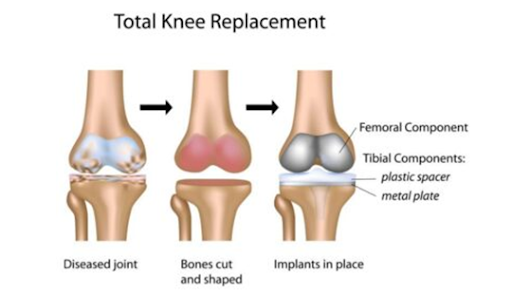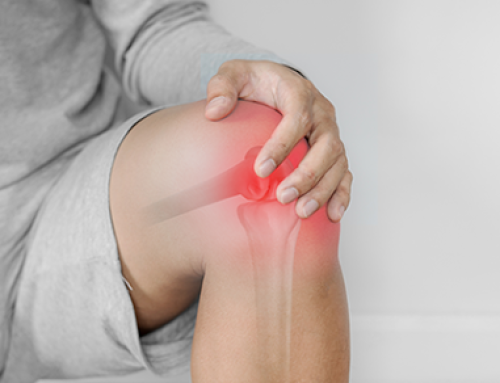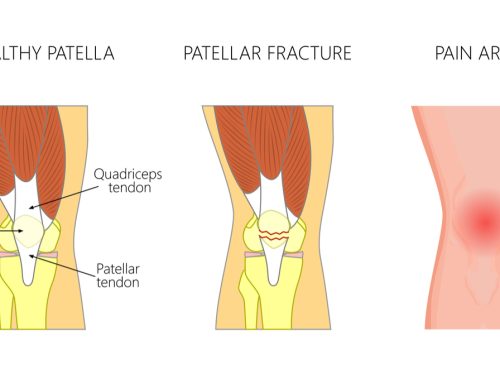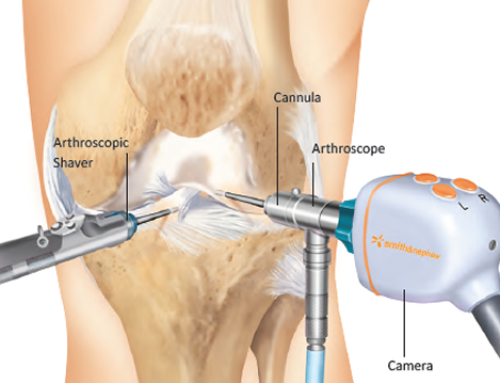Total Knee Replacement
The traditional technique for repairing a broken knee could be a total knee replacement surgery (TKR).
Since the primary operation in 1968, doctors have dramatically improved the procedure. In fact, advancements in medical technology have crystal rectifier to specific and extremely purposeful artificial knee implants that just about duplicate the means the human knee moves — and ar custom suitable your body. A TKR is currently among the safest and best of all commonplace orthopaedic surgeries.
During a TKR, a medico removes the surface of your bones that are broken by degenerative arthritis or alternative causes and replaces the knee with a man-made implant that’s elite to suit your anatomy. The medico uses special surgical instruments to chop away the rheumatoid bone accurately so form the healthy bone beneath to suit exactly into the implant elements.
Essentially, the surgery could be a four-step method. the primary half involves getting ready the bone by removing the broken gristle surfaces at the ends of the femur (femur) and tibia (tibia), similarly as alittle portion of underlying bone.
During consequent part, the medico positions the metal leg bone and leg bone implants and either cements them to the bone or press-fits them. “Press-fitting” refers to implants that designed with rough surfaces to encourage the bone in your knee to grow into them, therefore securing the implants organically.
The next step is to insert a plastic button beneath the kneecap (patella). this might need resurfacing the face of the kneecap so as to higher affix it to the button.
Finally, the medico implants a medical grade plastic spacer between the leg bone and leg bone metal elements so as to make a swish surface that glides simply and mimics the motion of the natural knee. so as to confirm a flourishing outcome, the medico should align the implants exactly and punctiliously work them to the bone.
The yankee Academy of orthopedic Surgeons reports that ninety p.c of these who’ve undergone TKR expertise a dramatic reduction in knee pain and take pleasure in improved quality and movement. Most ar able to resume daily activities.
However, it’s vital to line correct expectations and avoid high-impact activities like running and athletics. Moderate use of your artificial knee can increase the percentages that the implant can last for several years. regarding eighty five to ninety p.c of TKR implants still work well fifteen to twenty years when the operation.
Be aware that there ar risks ar related to a TKR. These risks embody infection that would lead to extra surgery, blood clots that would result in stroke or death, and continued knee instability and pain. A TKR conjointly needs AN extended program and residential aiming to accommodate the recovery amount. you must arrange on employing a walker, crutches, or a cane straightaway when surgery.
In addition, implant loosening or failures will occur — particularly if placement occurred between the implant and also the bone throughout surgery or subsequently. though these failures ar uncommon, and typically occur within the weeks following the first surgery, they might need a come back to the surgery for a revision surgery. throughout this procedure, the medico removes the unsuccessful implant, yet again prepares the bone, and installs a brand new implant.
Partial Knee Replacement
Partial knee replacement (PKR), generally noted as a uni-compartmental knee replacement, is associate possibility for atiny low share of individuals. so much fewer PKRs square measure performed than TKRs within the u. s..
As the name implies, solely a district of the knee is replaced so as to preserve the maximum amount original healthy bone and soft tissue as attainable. Candidates for this kind of surgery usually have degenerative joint disease in just one compartment of their knee. therefore surgery takes place in any of 3 anatomical compartments of the knee wherever morbid bone presents the foremost pain: the medial compartment settled on the within of the knee, the lateral compartment on the skin of the knee, or the patella limb compartment that’s positioned on the front of the knee between the leg bone and kneecap.
During a PKR, a doc removes the unhealthy portion of the knee — together with bone and animal tissue — and replaces that compartment with metal and plastic elements.
A PKR surgery offers many key blessings, together with a shorter hospital keep, quicker recovery and rehabilitation amount, less pain following surgery, and fewer trauma and blood loss. Compared with people who receive a TKR, those that receive a PKR typically report that their knee bends higher and feels additional natural.
However, there’s less assurance that a PKR can scale back or eliminate the underlying pain. and since the preserved bone remains prone to inflammatory disease, there’s additionally a larger probability that follow-up TKR surgery is also needed at some purpose within the future.
Surgeons sometimes perform PKRs on younger patients (under age 65) UN agency have many healthy bone remaining. The procedure is performed on one in all the 3 knee compartments. If 2 or additional knee compartments square measure broken, it’s most likely not the most effective possibility.
PKRs square measure most fitted for people who lead a lively manner and would possibly need a follow-up procedure — maybe a TKR — in twenty years some, when the primary implant wears out. However, it’s additionally used for a few older people UN agency live comparatively inactive lifestyles.
Because a PKR is a smaller amount invasive and involves less tissue, you’re doubtless to be up and concerning sooner. In several cases, a PKR recipient is ready to maneuver around while not the help of crutches or a cane in concerning four to 6 weeks — some 0.5 the time for a TKR. They additionally expertise less pain and higher practicality — and report high levels of satisfaction.
Types of Knee Replacement Approaches
Your doctor will opt for a surgical approach (as well because the approach to anaesthesia, whether or not general or regional) that’s best suited to your wants. You and also the medical team can interact in pre-operative coming up with that covers the sort of procedure you receive and associated medical needs.
In order to confirm a swish procedure, a talented orthopaedic operating surgeon can map your knee anatomy ahead so they’ll set up their surgical approach and anticipate special instruments or devices. this is often a necessary a part of the method. doable procedures area unit mentioned below.
Traditional surgery
In the ancient approach, the operating surgeon makes associate degree 8- to 12-inch incision and operates on the knee mistreatment customary surgical technique. Generally, the incision is formed on the front and toward the center (midline or anteromedial) or on the front and to the aspect (anterolateral) of the knee.
The traditional surgical approach sometimes involves cutting into the quadriceps femoris sinew so as to show the kneecap over and expose the rheumatic joint. This approach generally needs 3 to 5 recovery days within the hospital and regarding twelve weeks of recovery time.
Traditional surgery
In the ancient approach, the operating surgeon makes associate degree 8- to 12-inch incision and operates on the knee mistreatment customary surgical technique. Generally, the incision is formed on the front and toward the center (midline or anteromedial) or on the front and to the aspect (anterolateral) of the knee.
The traditional surgical approach sometimes involves cutting into the quadriceps femoris sinew so as to show the kneecap over and expose the rheumatic joint. This approach generally needs 3 to 5 recovery days within the hospital and regarding twelve weeks of recovery time.
Minimally invasive surgery
A operating surgeon could counsel a minimally invasive surgery (MIS) that reduces trauma to tissue, lessens pain, and reduces blood loss — consequently rushing recovery. A minimally invasive approach reduces the incision to three to four inches. A key distinction between this approach and also the customary surgery is that the kneecap is pushed to the aspect instead of being turned over. This ends up in a smaller turn over the {quadriceps|quadriceps femoris|musculus quadriceps femoris femoris|quad|extensor muscle|extensor} sinew and fewer trauma to the quadriceps muscle. as a result of the operating surgeon cuts less muscle, healing happens quicker, and you’re probably to expertise higher vary of motion once recovery.
The procedure modifies the techniques utilized in ancient surgery whereas mistreatment constant implants from ancient surgery. makers offer specialised instruments that facilitate to put the implant accurately however conjointly afford incisions to be created as tiny as doable. Since the sole amendment between MIS and ancient surgery is within the surgical technique, the semipermanent clinical outcomes area unit similar.
Types of minimally invasive approaches include:
Quadriceps-sparing approaches
After creating a token incision, the operating surgeon shifts the kneecap to the aspect and cuts away the rheumatic bone while not cutting through the quadriceps femoris sinew. The quadriceps-sparing technique, because the name suggests, is a smaller amount invasive than ancient surgery. It spares the quadriceps femoris muscle from the maximum amount trauma as doable.
Another term for this approach is “subvastus” as a result of access to the joint is taken from underneath (sub) the vastus muscle (the largest a part of the quadriceps femoris muscle group).
Another variation of a quadriceps-sparing approach is named midvastus. It conjointly avoids cutting the quadriceps femoris sinew, however rather than fully economical the vastus muscle by sinking it, during this surgical approach the muscle is split on a natural line through the center. the choice to use one approach versus another depends on the condition of your knee and close tissues.
The subvastus and midvastus approaches typically take longer to perform however could lead to a quicker rehab method. this is often as a result of there’s very little to no trauma to the underlying thigh muscle, creating it easier to run sooner once the operation.
Lateral approach
This approach is never used. It’s a lot of common for those whose knees tend to bend outward. The operating surgeon enters the ginglymus laterally, or from the aspect of the knee. The lateral approach is a smaller amount invasive than ancient surgery as a result of it spares abundant of the quadriceps femoris, creating it easier for patients to come to walking quicker.
Minimally invasive surgery trims the hospital keep to 3 to four days and it will shorten the recovery amount to four to 6 weeks. folks that get a PKR toughened less pain and were ready to resume daily activities quicker and higher than those that had customary surgery. At one year, however, there have been no vital variations between the 2 teams.
Minimally invasive approaches aren’t acceptable for everyone. Surgeons fastidiously value every patient and choose the approach that’s best. Also, minimally invasive surgery is tougher to perform and needs a a lot of specific technique, instruments, and surgical coaching. One study found that it needs regarding one hour longer than a conventional surgery. Consult your operating surgeon to debate your choices.
Computer-assisted surgery (CAS)
Increasingly, surgeons are turning to computer-assisted strategies for each TKRs and PKRs involving each ancient and minimally invasive procedures. A operating surgeon enters a patient’s anatomical information into a pc — a method known as “registration” — and also the pc generates a 3D model of the knee.
The package provides the operating surgeon with a a lot of precise, computer-aidedimage of the knee. the pc helps the operating surgeon align the knee elements a lot of exactly within the bone and will increase the percentages that the device can work effectively.
A computer-based approach conjointly permits a operating surgeon to control with a smaller incision and edges the patient by reducing recovery time. A a lot of precise match may scale back wear and increase the longevity of the new joint.





